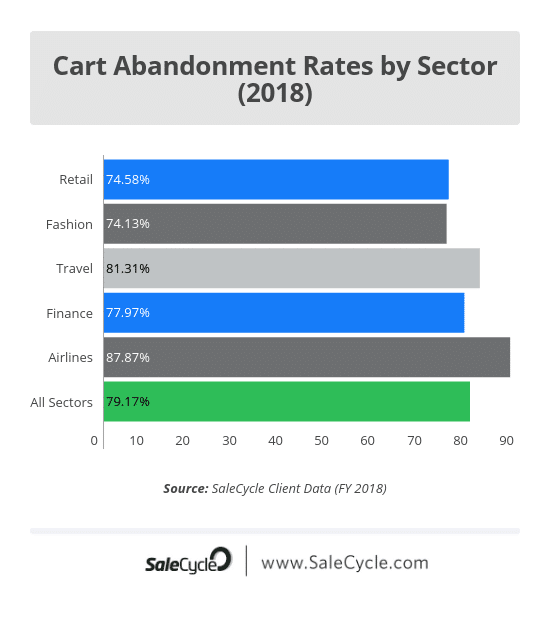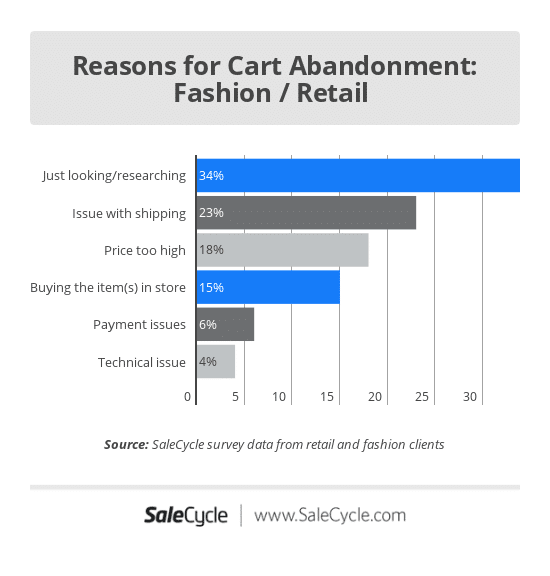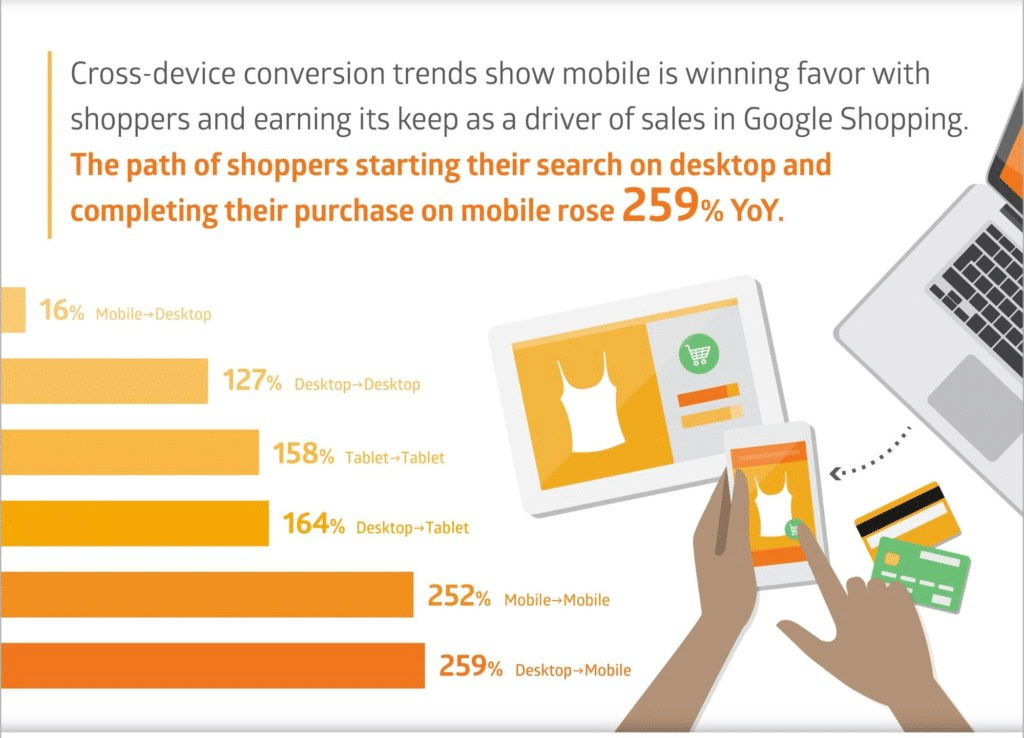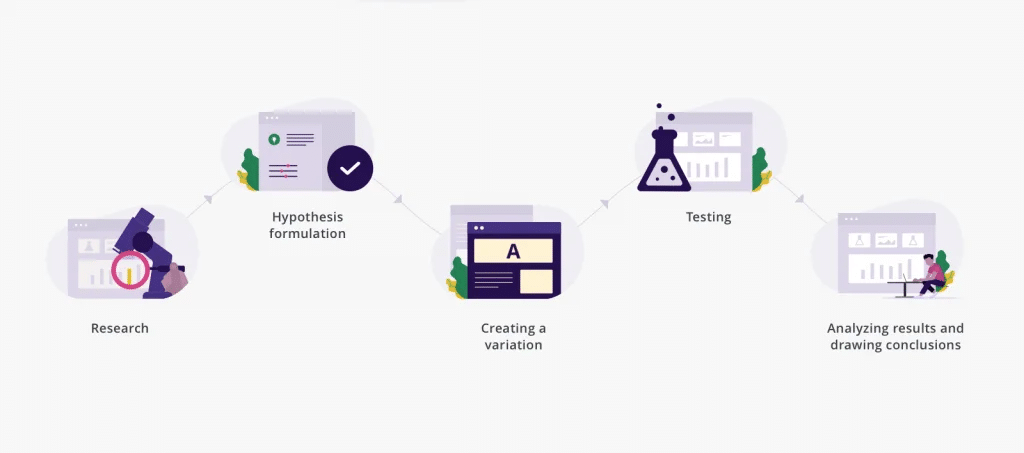Shopping cart abandonment is one of the most common issues merchants face when selling online, with an average of 81% of consumers abandoning their cart before completing a purchase.
Some sectors, such as travel face even higher rates of cart abandonment, rising as high as 85%. So what are the reasons behind the levels of shopping cart abandonment when shopping online? And what can be done to resolve the issue?
What is shopping cart abandonment?
Shopping cart abandonment is when a customer begins the process of purchasing an item from an online store, but never completes it. Items that are added to the shopping cart (or basket) but never checked out are considered to be abandonment items.
Whilst cart abandonment rates are generally quite high for online stores, it is still important to keep track of yours, and compare it to the average in your sector. A higher than average cart abandonment rate could indicate flaws on your website, cart, or business practices.
Calculating the impact cart abandonment has on your business
Cart abandonment is often stated as a percentage, which is worked out by taking the number of transactions completed and then dividing it by the total initiated. For example, if one transaction was completed and ten were initiated, the cart abandonment rate would be 90% as the completed transactions were only 10% (one divided by ten).
To establish whether your cart abandonment rate is impacting your business, you can compare your rate against that of your industry average. If your cart abandonment rate exceeds that of your industry average, it can have serious negative implications for your business.
Higher than average cart abandonment can lead to lower than predicted sales, higher storage fees, and potential financial losses. However, if you do find yourself in that unfortunate situation, you should avoid panicking or making any rash changes to your store. There are usually very rational reasons behind high cart abandonment rates, and generally, the impact of high cart abandonment can be lessened with the right solution.
Source: Sale Cycle
10 reasons for people abandoning their shopping carts
Distrust and security
A common reason for people abandoning their carts is distrust in a brand or a lack of visible security. If an online store is relatively new or lacks customer reviews on buying through it, many customers may decide to look for a similar item elsewhere.
Security issues also play a part in this. Even if a store is secure, if the SSL certificate isn’t visible, people may buy elsewhere due to perceiving the platform as unsafe. In order to have a high level of security on your ecommerce website remember about getting good ecommerce web hosting.
Complexity
The complexity of the purchasing process could also turn people away before completing their purchase. Overly detailed forms, a confusing website layout, or hard to understand elements of the checkout could cause people to give up on buying through a store.
Lack of payment options
Another frequent reason for people abandoning their carts is a lack of payment options. People like to pay in a wide variety of ways. Payment choices are often quite personal to the buyer, with some options feeling safer and more practical to them. If they cannot pay using their payment option of preference, they may decide to not complete their purchase.
Shipping or delivery costs that weren’t clear upfront
This is one of the most common reasons for people abandoning their carts. By not showing the true shipping or delivery costs prior to checkout, you give customers a nasty surprise when they suddenly see a much higher price for the items they originally added to their cart. This can be off-putting for many, especially if it is a significant difference between the two prices.
The length of expected shipping time
Lengthy shipping times are another common reason for users abandoning their cart. When people order online, they will almost always favor the quicker delivery option. So if your shipping takes longer than another store; perhaps due to the location of the store, buyer, or supplier, then the customer will likely look elsewhere and therefore fail to complete their purchase.
Low purchasing intent
Many users will not complete their purchase simply because they have a low purchase intent. Perhaps they were just browsing, researching, or comparing prices to those on other stores. Carts are also frequently used as a way for customers to store products they are interested in, which could also lead to a high cart abandonment rate.
Lengthy purchasing process
Another deterrent for shoppers is a lengthy purchasing process. If it takes too long to get through the checkout process, many customers will give up and go elsewhere. Lengthy purchasing processes are usually caused by asking for too many details that can be attained in follow-up stages.
Poorly optimized website on mobile or tablet
Websites that aren’t optimized for use on all devices are also a frequent reason for cart abandonment. Shopping via a mobile website or app is an ever-developing trend, so if websites aren’t clear and easy to use on smaller screens (especially when entering checkout details), you risk losing out on purchases.
Lack of checkout navigation
During the checkout process, customers may want to go back to a previous page and amend details. For that reason, checkout navigation is vital. Should a store lack checkout navigation, customers aren’t able to check previous information they entered, or see how far along the checkout process they are. Both of these factors may cause them to abandon the purchase entirely.
Technical issues
Technical problems are an obvious cause of cart abandonment. Any bugs can at least temporarily stop the checkout process from operating smoothly, or even completely. This in turn makes people give up on their purchase.
Source: SaleCycle
How to reduce shopping cart abandonment
Build trust with your buyers
Building trust with your buyers is one of the most effective ways to reduce shopping cart abandonment. You can build trust in a few ways, including:
- Displaying your SSL certificate and trust seals clearly so buyers know it’s safe to shop with you
- Allow reviews on your products so customers can see opinions from other buyers
- Highlight your returns and cancellation policies
- Be clear on pricing and avoid surprising customers
- Get authorities on your niche to promote your brand and products
- Make sure that good words about your company are being spread, take care of referral programs
Source: Website Pulse
Use progress indicators at your checkout
Progress indicators help to show customers how far into the checkout process they are. This will encourage them to complete the process if they are near the end, or at least give them an idea of how long the process will take to complete. Progress indicators can also allow customers to go back to previous steps in the checkout process and amend anything they may need to.
Maximize payment options
More payment options mean that more of your potential buyers can pay in the manner of their choosing. By providing a potential buyer’s payment option of choice, you offer a way for them to buy that they are comfortable with, familiar with, and therefore trust. This increases the chances of them completing the purchasing process.
Make purchasing quick and easy across all platforms
An increasing amount of people buy online using mobile or tablet devices. This means you need to have a well-optimized website for all kinds of users. By optimizing your site for mobile and tablet users, you make checkout on such devices much easier, and therefore customers are less likely to abandon their carts.
Source: Jilt
Allow carts to be saved for later
By allowing carts to be saved for later, you can reduce your cart abandonment rate. This is because when customers who previously couldn’t purchase for one reason or another decide to return to your store, they will still have access to previously saved items, and may now be able to complete the purchase.
The best way to remind them about their cart is by sending them tailored emails. Here is a list of the best email marketing tools that you can use to automate that process.
Create a sense of urgency with calls to action
Many customers who add items to their basket are only browsing or doing research. These passive users may come back to purchase at a later date. However, that is not a certainty.
Therefore, it is better to use an effective call to action to create urgency when they initially add items to their cart. Phrases such as ‘buy now’ combined with ‘stocks low’ can help to convert a few more of those passive browsers into active customers.
Show all costs upfront when possible
By showing all the costs upfront, your customers don’t get any nasty surprises when they go to checkout. If you don’t have exact shipping prices in advance, try to present the general range of costs so customers know what to expect. Alternatively, you can let customers choose their shipping from a variety of options. That way, they pay for exactly what they want and need.
It is also recommended that you show prices with taxes included, especially if you are selling internationally. The law in many countries states that prices should include VAT, so this will also help you avoid potential legal issues. In addition, many customers will not expect a price rise at checkout because of this law, so it would put them off the purchase anyway.
If you are selling in a country that does not include tax before checkout, you should make the tax rate clear nonetheless, or even mention that you have already included tax if you have done so.
Offer a guest checkout option
By offering guest checkout, you give customers who do not have an account with you the chance to make a purchase.
Guest accounts require minimal details for a purchase to be completed, which can help to push customers over the line due to the speed and lack of intrusiveness of the setup. This can help in converting those who are unsure about signing up, or unsure on providing details initially due to a lack of trust.
Once a customer has used your guest checkout, you will still be able to reach out to them through email marketing anyway. So there is still plenty of opportunity and time to build trust and establish a relationship with the customer.
Utilize remarketing
Regardless of how foolproof your checkout system is, there will always be a degree of cart abandonment. However, that doesn’t mean you can’t find a new way to reach out to customers who didn’t complete their purchase.
By using remarketing, you can advertise to customers who have previously spent time browsing your store. You can lure these potential customers back with sales, or something else to catch their attention. As they have already shown interest in your products, they are more likely than the average consumer to complete a purchase, especially at a discounted price.
Furthermore, remarketing can also help remind those who intended to complete their purchase but were waylaid.
A/B test your checkout design
Testing different checkout options such as the layout, process, or even color scheme may help you to find ways to improve things. By conducting frequent A/B testing, you can compare the success rates of one checkout design to another, which will give you a better idea of where some of your cart abandonment issues lie.
It is also worth doing A/B testing regularly, even if you have a relatively low cart abandonment rate. After all, it doesn’t hurt to find new ways to improve.
Source: VWO
Final thoughts
A degree of cart abandonment is inevitable for any online shop. However, it is important to recognize the flaws in your store, especially if your cart abandonment rate is in excess of your industry average.
By following these solutions, you can gradually reduce the level of cart abandonment and make your store as profitable as it can be.









